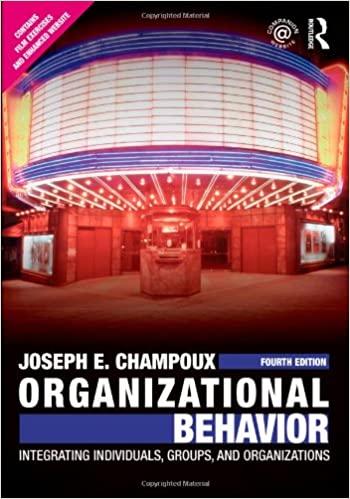Which parts of Herzbergs motivatorhygiene theory made useful contributions to understanding motivation in organizations? Herzbergs motivatorhygiene theory:
Question:
Which parts of Herzberg’s motivator–hygiene theory made useful contributions to understanding motivation in organizations?
Herzberg’s motivator–hygiene theory:
Frederick Herzberg’s motivator–hygiene theory is not based directly on needs. It also does not fit neatly with the cognitive and behavioral theories described in the next chapter. It is useful as a transition between purely need-based theories and those based on cognitive and behavioral processes.
In developing his theory, Herzberg did his early research using samples of accountants and engineers. Each person was interviewed and asked to recall a past work event that was especially positive or negative. The interview responses were content-analyzed to decide whether any relationships existed between positive and negative events and aspects of the job or work organization.
Herzberg found that reports of negative events had items that mostly involved a person’s job context. Negative reports described company policy, its administration, working conditions, and supervision more often than reports of positive events. The positive reports described aspects of the job itself, a feeling of achievement, and a feeling of responsibility. The person’s salary was mentioned about the same proportion of time in both negative and positive reports. Herzberg called the items predominantly found in descriptions of negative events dissatisfiers. He called those found in descriptions of positive events satisfiers. Dissatisfiers could lead to high levels of employee dissatisfaction. If management improved the dissatisfiers, employees would feel a reduction in dissatisfaction, but not higher satisfaction. Satisfiers could lead to high levels of employee satisfaction, but their absence or a person’s failure to experience them would not produce dissatisfaction.
Herzberg’s observations on satisfaction and dissatisfaction differed from commonly held views. The traditional view saw a single continuum with satisfaction at one end and dissatisfaction at the other. Herzberg’s research suggested two distinct continua, one for satisfaction and one for dissatisfaction. In short, different aspects of an employee’s experiences contributed separately to satisfaction and dissatisfaction.
Herzberg eventually called the satisfiers motivators and the dissatisfiers hygiene factors. The motivators included achievement, recognition, and the work itself. Hygiene factors included company policies and their administration, quality of supervision, and working conditions. Managers first must improve the hygienic conditions of work before trying to increase motivation. Negative hygienic conditions distract employees from experiencing the motivators. After the work context is improved, the manager can try to provide the motivators by redesigning jobs using a process Herzberg called job enrichment. By adding more responsibility and autonomy to the job, the manager creates the opportunity for an employee to experience the motivators.
Empirical research designed to test the motivator-hygiene theory has had mixed results. The work of Herzberg and his colleagues, using the retrospective interview technique, has supported the distinction between motivators and hygiene factors. Work by other researchers using other research methods, however, has not produced confirming evidence. Some also have questioned the basic validity of retrospective interviews. As Chapter 5, “Perception, Attitudes, and Personality,” explained, people can attribute positive work experiences to themselves and negative experiences to external factors.
There are, of course, two sides to this critique. Herzberg responded to the question of attribution by arguing that more conventional methods of measurement produce bias. His use of retrospective interviews was a deliberate effort to avoid such bias.
Step by Step Answer:

Organizational Behavior Integrating Individuals Groups And Organizations
ISBN: 9780415804646
4th Edition
Authors: Joseph E. Champoux





